DARLINGTON RACEWAY - DARLINGTON SC
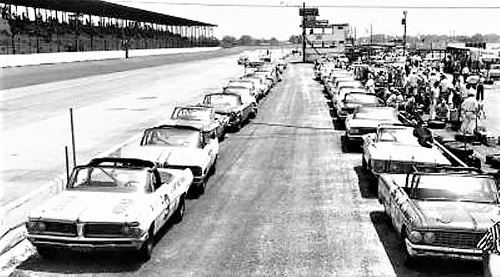
Harold Brasington was a retired racer in 1948 who had quit racing in the late 1940s to concentrate on farming and his construction business. He began planning a new speedway after he noticed the huge crowds while attending the 1948 Indianapolis 500 and thought, "If Tony Hulman can do it here, I can do it back home." Brasington bought 70 acres from farmer Sherman Ramsey, and started making a race track from a cotton and peanut field. However, he was forced to create an egg-shaped oval with one corner tighter, narrower, and more steeply banked because he promised Ramsey that the new track wouldn't disturb Ramsey's minnow pond at the west side of the property. It took
almost a year to build the track. It is a paved track slightly over 1 1/2 miles in length. This old gal has a lot of history. Whether you call her "The Lady In Black"; The Track Too Tough To Tame"; and the drivers run the high line and get a "Darlington Stripe". It's egg-shaped design, and an abrasive surface which eats the rubber off of tires in mere laps. This situation makes it very challenging for the crews to set up their cars' handling in a way that will be effective at both ends. Brasington made a deal in the summer of 1950 with France to run a 500-mile (800 km) race in Darlington on Labor Day that year. The first Southern 500 carried a record $25,000 purse. More than 80 entrants showed up for the race. Brasington used a 2-week qualifying scheme similar to the one used at the Indianapolis 500. Brasington was also inspired by Indianapolis when he had the 75-car field aligned in 25
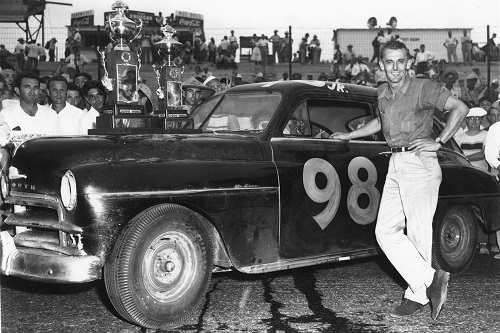
Johnny Mantz 1950 winner
aftermath of Bobby Myers fatal crash
rows of three cars. The track was built and designed to run speeds of 120 mph and race around the inside line on the flat part of the track. The banking was meant for slow cars to get out of the way. It turns out that now drivers qualify at speeds of 180 mph with drivers running right up against the outside wall. The first race was the first 500 mile race in NASCAR. It was the only paved track race in 1950 and saw Johnny Mantz use an unusual strategy in the race. Mantz and his Plymouth was the slowest qualifier for the race; almost 10 mph slower than pole winner Curtis Turner. For the race Mantz outfitted his car with truck tires. He knew these would much tougher and would not wear quickly or be prone to blow out. The tires the other drivers used wore and they had to stop often to pit for new tires. In fact, tires became such an issue and race teams resorted to going into the parking lot and getting tires off of spectators cars to run the race on. Of course, during that time, a four tire change was a time consuming ordeal. As it turned out, Mantz never had to change tires during the
entire race; only pitting for fuel. Thus he saved tons of time not changing tires, a strategy which saw him go on to win the race by over nine laps. The race took more than six hours to run. (Note picture above of Mantz and trophies on hood) The race automatically became one of NASCAR's "Crown Jewel" events. At track that has been around since 1950 has a lot of stories to tell; but I'll cover a couple highlights. Cale Yarborough went over the fence; and ABC used the footage for many years in it's open for Wide World of Sports. Darlington has saw it's share of tragic incidents. In 1952 Rex Stansell was involved in a multi-vehicle crash and would lose his life. Bob Scott would perish in 1954. Bobby Myers would be killed in the Southern 500 in 1957. Fonty Flock spun at the end of the back straight. Flock drove a black car which made it hard to see as it blended in with the color of the asphalt. Meyers came tearing down the back stretch and plowed wide open into Flock, flipping multiple times and destroyed the car. Paul Goldsmith was also caught up and crashed hard. The crash seriously
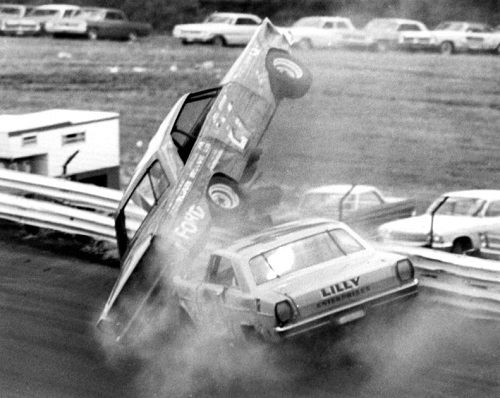
Cale Yarborough goes out of the park
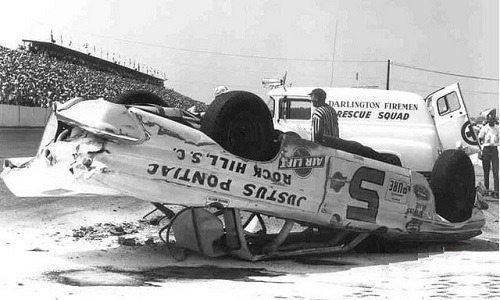
Bobby Jones pit road crash - 1960
injured Goldsmith, ended Flock's career, and killed Myers. Multiple deaths occurred in 1960 as a car driven by Bobby Johns made contact with another car and came spinning into the pits. There was no separation between the track and pits back then. John's car scattered gas cans, parts, and bodies everywhere. Paul McDuffie, Charles Sweatland, and NASCAR official Joe Taylor, were killed in the accident. To date the last fatal accident took place in 1965. Driver Buren Skeen spun coming out of turn three on lap four and was struck broad side in the driver door. The door was pushed in by at least a foot intruding into the drivers area greatly. Skeen was rushed to the hospital with a broken leg, and head, chest and abdominal injuries. He would later pass away from the injuries. In 1970, Richard Petty
would suffer a heavy crash as he slammed into the pit wall on the front stretch. Many watching thought he had been killed. When the car stopped, it was upside down with Petty half hanging out. It was reported he had a dislocated shoulder and was back racing before long. On happier notes we would see Terry Labonte win both his first career Cup race (1980) and last (2003) with Southern 500 victories. David Pearson hold the record for most wins at Darlington (10) while Dale Earnhardt Sr has nine and Jeff Gordon seven. Four drivers have five wins - Bobby Allison, Darrell Waltrip, Cale Yarborough and Bill Elliott. I would be remiss to not point out 1985 when Elliott won the "Winston Million". Sponsor RJ Reynolds put up a one million dollar bonus if any driver could win three our of four major races. The Daytona 500 at Daytona, the Winston 500 at Talladega, the World 600 at Charlotte, and the Southern 500 at Darlington. Elliott won at Daytona and at Talladega. But suffered issues at Charlotte. Dale Earnhart
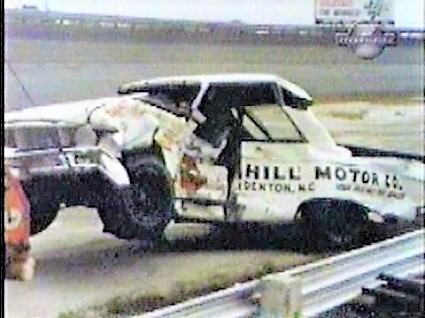
Buren Skeen's fatal crash
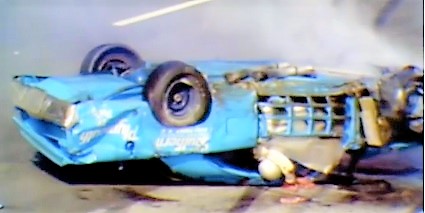
Richard Petty 1970 crash
had a stout car and led 147 laps and looked to deny Elliott his chance at the million. But Earnhardt's motor billowed smoke with just 18 laps to go; ending his day. Over the last 80 laps Cale Yarborough and Elliott swapped the lead; but late in the race Yarboroughs car also punked out a pume of smoke. Everyone thought he had blown his motor also; but as it turned out his power steering hose had blown off. A yellow flew and everyone pitted. When the green flew only three cars remained on the lead lap as Geoff Bodine had a shot at the win also. Neither driver was ever able to pass Elliott as he led the final 44 laps to collect the win and million dollars. For many years, Darlington
was the site of two annual NASCAR Cup Series races. One, the Rebel 400, was held in the spring while the other, the Southern 500, was always held on Labor Day weekend. In later years the track was reconfigured; since 1997, what was the front stretch is now the back stretch, from late 2003 to early 2004 lights were installed for night racing to beat the heat. Seating has been increased to approximately 65,000, although it has been limited by the proximity of a highway behind the back stretch and another pond; the original minnow pond is long gone. In 2003, the Labor Day race was given to California Speedway, and the Southern 500 was moved to November 2004 and was run as part of the Chase. Darlington received a $10 million upgrade in 2008, the largest investment in the track's history. This followed a $6 million upgrade the previous year, which included an entire

Million Dollar Bill
repaving of the oval for the first time since 1995. In 2014, Darlington swapped dates with Kansas Speedway and was run in April. In 2015, the Southern 500 returned to its traditional Labor Day weekend date. It encouraged drivers o run 'throwback" paint schemes to honor many of the great drivers of the past. It was well received and has been done each year since. A link can be found on this web site showing yearly throwback paint schemes HERE
All Photos copyright and are property of their respective owners
